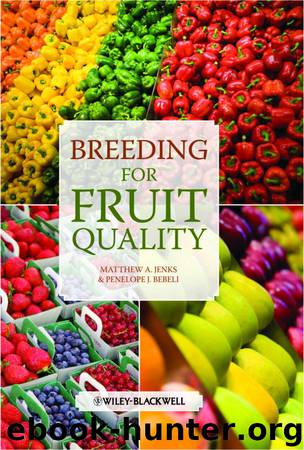Breeding for Fruit Quality by Matthew A. Jenks

Author:Matthew A. Jenks
Language: eng
Format: epub
Publisher: Wiley
Published: 2011-01-12T05:00:00+00:00
Issues with Breeding for Fruit Quality
To produce new cultivars quickly and efficiently, breeders tend to use only a few high quality parents.Noiton and Alspach (1996) analyzed the pedigrees of 50 apple cultivars produced from modern breedingprograms around the world. They revealed that ‘Cox’s Orange Pippin’, ‘Golden Delicious’, ‘Red Delicious’, ‘Jonathan’, and ‘McIntosh’ were the most frequent progenitors, and there were high levels of coancestry among many modern cultivars. They warned that further use of the five founding clones or their descendants would increase the risk of inbreeding in future generations. Breeders are currently working with reduced genetic diversity and, therefore, must attempt to expand the genetic base. To maintain genetic diversity for future apple breeding, Plant and Food Research (formerly Hort Research) in New Zealand has undertaken a recurrent selection program, which began in 1990 (Kumar et al., 2010).
Recently, the identification of QTL for characters related to fruit quality has been thoroughly reported. Because a saturated genetic map is necessary for the genome wide QTL analysis, molecular markers that are close to the genes underlying the quantitative traits are only developed using restricted populations derived from crossings between a few cultivars. Therefore, it is uncertain whether the markers can be useful to other cultivars and whether the QTL localized to the maps of a particular cultivar are validfor other cultivars. For example, QTL analysis for acidity was performed using a population of ‘Fiesta’× ‘Discovery’, and two QTL, which explained 98% of the phenotypic variability attributed to the cultivars, were identified only on the genetic map of ‘Fiesta’, even though the malic acid contents of ‘Discovery’ were identical to those of ‘Fiesta’ (Liebhard et al., 2003). The authors presumed that the reason is that all loci involved in the acidity are homozygous in ‘Discovery’, and the differences in phenotype produced by the alleles inherited from ‘Discovery’ are not observed in the population analyzed. It would be an error to conclude that ‘Discovery’ does not inherit alleles affecting acidity even though QTL for acidity were not detected on the map of the cultivar. Another important difficulty in using molecular markers associated with QTL as a tool for progeny screening in breeding programs is that the stability of the marker has not been ensured across different environments or genetic backgrounds.
Download
This site does not store any files on its server. We only index and link to content provided by other sites. Please contact the content providers to delete copyright contents if any and email us, we'll remove relevant links or contents immediately.
Whiskies Galore by Ian Buxton(41535)
Introduction to Aircraft Design (Cambridge Aerospace Series) by John P. Fielding(32892)
Small Unmanned Fixed-wing Aircraft Design by Andrew J. Keane Andras Sobester James P. Scanlan & András Sóbester & James P. Scanlan(32576)
Aircraft Design of WWII: A Sketchbook by Lockheed Aircraft Corporation(32139)
Craft Beer for the Homebrewer by Michael Agnew(17936)
Turbulence by E. J. Noyes(7704)
The Complete Stick Figure Physics Tutorials by Allen Sarah(7144)
The Institute by Stephen King(6806)
Kaplan MCAT General Chemistry Review by Kaplan(6601)
The Thirst by Nesbo Jo(6442)
Bad Blood by John Carreyrou(6281)
Modelling of Convective Heat and Mass Transfer in Rotating Flows by Igor V. Shevchuk(6227)
Learning SQL by Alan Beaulieu(6039)
Weapons of Math Destruction by Cathy O'Neil(5837)
Man-made Catastrophes and Risk Information Concealment by Dmitry Chernov & Didier Sornette(5655)
Permanent Record by Edward Snowden(5542)
Digital Minimalism by Cal Newport;(5395)
Life 3.0: Being Human in the Age of Artificial Intelligence by Tegmark Max(5193)
iGen by Jean M. Twenge(5164)
